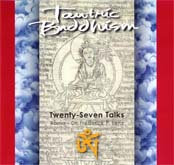
Tantric Buddhism
The Bhagavad-Gita
In the Bhagavad-Gita is a discussion-conversation between enlightenment and that which unknowingly seeks enlightenment.
Enlightenment is represented by Sri Krishna who is said to be an avatar, which is a human way of trying to define "very big." That is to say that Sri Krishna is not from the local area network, but he has come from a world that is different because his mind is different. He glows. He doesn't experience the normal round of circumstances inwardly that most people do. He doesn't experience depression. He doesn't really experience elation as human beings would know it. He doesn't experience the kind of grayness and deadness of the human condition. Instead he lives in a perpetual sunrise. He's self-effulgent. The light that he seeks is not external. He doesn't have to turn to the sun for light, or towards another being or towards a God, because he is self-effulgent radiance.
Arjuna, who is the fearless warrior in the story, on the other hand is a very worldly individual, we assume with high past lives, who's engaged in a battle, a kind of a civil war, the battle of Kurukshetra. And a conversation, a dialogue, ensues in the middle of a battlefield, symbolizing the battlefield of life in which we are fighting through our illusions. The illusions that are most dear to us are Arjuna's illusions. His illusions are the people he must fight against. It's a civil war, and he knows a lot of people who are on the opposite side of the battlefield. They've been his friends. But simply because of a political difference, which was not necessarily their doing or his doing, suddenly they have to face each other down. You've got to kill your friends.
Arjuna is a warrior of great renown. Says he won't fight. He tells Krishna, I can't fight because I love these people. It's immoral, it's unjust. I can't - what will it prove? Where is the success in battle to kill those you care about? There's no winning. So he says, I won't fight.
Now what this represents - of course, this was an actual battle - but symbolically what this represents is a place we get to inside our mind. We get to a certain place inside our mind where we're slaying illusions in the practice of yoga and Buddhism. And we're doing a pretty good job, and it's going well. And we get to be a pretty good warrior, like Arjuna. But there comes a point where we reach certain attachments, certain illusions that we have to dispel. And we don't want to. We see no reason; we'd rather not gain the benefits of enlightenment than slay those illusions. We're so attached to them; it's illogical, of course, but it happens.
The ensuing dialogue is a pep talk from Sri Krishna, who represents enlightened mind, to Arjuna, who represents mind that seeks enlightenment, unconsciously. And he explains to him the nature of that which is and that which is not. He talks to him about reality. In other words, Arjuna is so - his mind has been so eclipsed by his attachments and his illusions, he's not seeing things well, that he doesn't want to do what he does best. He doesn't want to fight.
Krishna's message, which is definitely not a pacifist message - I know pacifism is associated sometimes in the world of yoga and Buddhism, but not always. Not always. Buddhists make great warriors. And Krishna says, fight. He says, go out in the battlefield and kill those people whom it's your job to kill. And whether they were your friends or not, you have to look at the big picture. In the big picture, you can't go kill anybody, you can't be killed.
In the big picture, we're all eternal. Yet, strangely enough, even though we are all made up of light and we are all one light, life is a game and in that game we find ourselves cast in certain roles. We call that lila - when the light takes forms. And when the light takes forms, we get cast into a certain role. Now maya, which is illusion, means that we believe that we are the forms. We get so caught up in the formations of life that we perceive through the senses that we actually believe that we are the forms and we forget that we are really essence, not forms.

